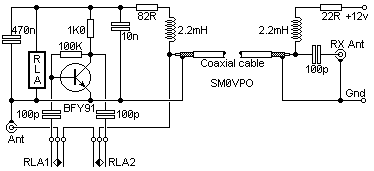

I have received several requests for a masthead preamplifier for use in the VHF spectrum. The power and switching circuitry may be made independant of the frequency so here I have presented two versions of a circuit I used whilst living in England. My first circuit is a simple preamplifier showing the power arangements for conveying DC to the amplifier via the coaxial cable. The second circuit is a small modification so the antenna can still be used for transmitting.

RECEIVE ONLY
Here is a practical circuit of an RF masthead preamplifier with DC power provided down the coaxial feed-cable.

The actual preamplifier in this circuit is a practical wideband amplfier that gives about 15 - 20dB of gain from 1.8 MHz through to well over 200 MHz. You will no-doubt replace this circuit for your own favorite amplifier for the band you are interested in. The 2.2mH chokes should have an absolute minimum reactance of 5000 ohms at the lowest frequency to be used. For 145 MHz these may simply consist of a few turns of wire. I personally used a 10-turn 4mm Dia. coil in series with a 2.2mH torroidal inductor.

TRANSMIT and RECEIVE
The above circuit may be modified to allow a transmitter to be used through the masthead preamplifier with the addition of a relay switch.

The relay should have a coil resistance in excess of 1000 ohms and have two-pole changeover contacts. When I built this circuit I used two 5v PCB mounting relays, each having a single pole changeover contact. The relays each had a 560 ohm coil.
If the DC power is switched OFF the preamplifier will become inactive and the relay will pypass the amplifier. In this manner it may be used with a low-power transmitter (typically up to 10 watts). My first switch was built inside the balun housing of a 2-metre beam antenna.
Note that the DC 12 volts should NEVER be applied whilst transmitting or the poor little BFY91 will be blown to bits. There is also a short delay between removing the DC and the preamp dropping out into a safe condition for transmitting. I should have used a pair of back-to-back diodes across the input to the preamp (before the 100p) to protect the preamp, but I got away with it for a couple of years without a problem.

Have fun, de HARRY, Upplands Vasby, Sweden,
